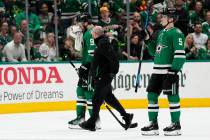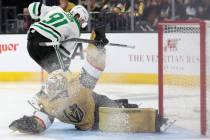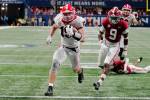Hope for baseball’s future at Williamsport
WILLIAMSPORT, Pa.
It is so green. Brilliant. Deep. Lush. Spectacular. A color born from the steadiness by which rainfall sprinkles this art community defined by a famous structure that welcomes the world’s best Little League players each summer.
Tucked into mountains that act the part of protective blanket, Howard J. Lamade Stadium has a capacity of 40,000 and is home to the Little League World Series, which begins again this week by welcoming 16 new teams to its field of hopes and dreams and memorable home runs mashed onto a massive hill beyond the outfield fences.
But this year is different. Historically so. Significant moments will play a major role in this annual act playing out once games begin Thursday, from the feel-good story of a Mountain Ridge side becoming the first team from Nevada to compete on this stage to a topic far grander in that which has been felt lost from youth baseball for years.
Black is a critical color here as well this week.
The numbers are painfully obvious. Baseball seemingly vanished from urban fields long ago and the decline in U.S.-born black players and fans in Major League Baseball has been steady and consistent for more than two decades.
The percentages have reached such disappointing levels that commissioner Bud Selig created a 17-member diversity task force last year to study and address the issue of African-American participation in the majors.
It is research that should begin at the youth level, with a team like Jackie Robinson West and a player like Mo’Ne Davis.
Jackie Robinson West will represent the Great Lakes Region, the first all-black team from Chicago to make the Little League World Series in 30 years. It will be a major story here and deservedly so. Those closest to the team don’t understand why their presence is such a big deal. It is.
So too is the arrival of Davis, the 17th girl to play in a Little League World Series and an African-American female who pitches for Taney (Pa.) and who on Sunday became the first girl to throw a complete-game shutout in a regional final when she blanked Newark (Del.) National 8-0.
She was asked afterward what her signature pitch is.
“A strike,” Davis answered.
Yep. Talent and moxie.
“You have 13 African-American players on our team, volunteer coaches, and everybody throughout the league trying to do something positive for the city of Chicago,” Jackie Robinson West manager Darold Butler told local reporters. “So this is huge. This gives our kids something to strive for, to set goals, and to accomplish. It gives them something to look forward to outside of the negativity.
“It’s like we’re in baseball heaven.
It’s not to say any success Jackie Robinson West or Davis finds during the next 12 days or so will over time alter a trend many believe can’t be turned. The majors consisted of nearly 30 percent black players in the 1970s. That number is 8.3 percent today. That sort of downturn begins far before anyone is prepared to wear a Major League uniform.
Jackie Robinson broke the color barrier in 1947. Greats like Ernie Banks and Hank Aaron and Willie Mays later built their own Hall of Fame careers. Ozzie Smith. Barry Bonds. The late Tony Gwynn.
Now the numbers are grim and reasons plentiful for why so few African-American youth choose to pursue baseball when it comes time to pick a sport.
It always comes back to money. Whether it’s those travel teams charging thousands of dollars a year or the partial scholarships that can’t cover enough of the cost for college, many urban youth have found it difficult to keep up with the game financially. The disconnect begins with the wallet from what are often one-parent homes.
But strength in community has been most noted when talking about how Jackie Robinson West built such a talented team as the one that will play here, the same sort of public support being given a certain Philadelphia girl and her teammates.
There might not be a major leaguer among them. There might not be anyone with the skill and promise of Gary Sheffield, who hit 509 career home runs in the majors, years after leading his Tampa (Fla.) based All-Star team to the Little League World Series. One of his teammates back then: Derek Bell, another African-American destined for a major league career.
That was 1980.
This week, a famous Little League structure protected by those brilliant, deep, lush, spectacular green mountains will be defined in large part by a different color.
And that’s important, no matter the long-term change it might create.
Las Vegas Review-Journal sports columnist Ed Graney can be reached at egraney@reviewjournal.com or 702-383-4618. He can be heard from 11 a.m. to 2 p.m. Monday through Friday on “Gridlock,” ESPN 1100 and 98.9 FM. Follow him on Twitter: @edgraney.
Related stories
Funding sought for Little Leaguers’ families
Williamsport no dream for Mountain Ridge Little Leaguers
































